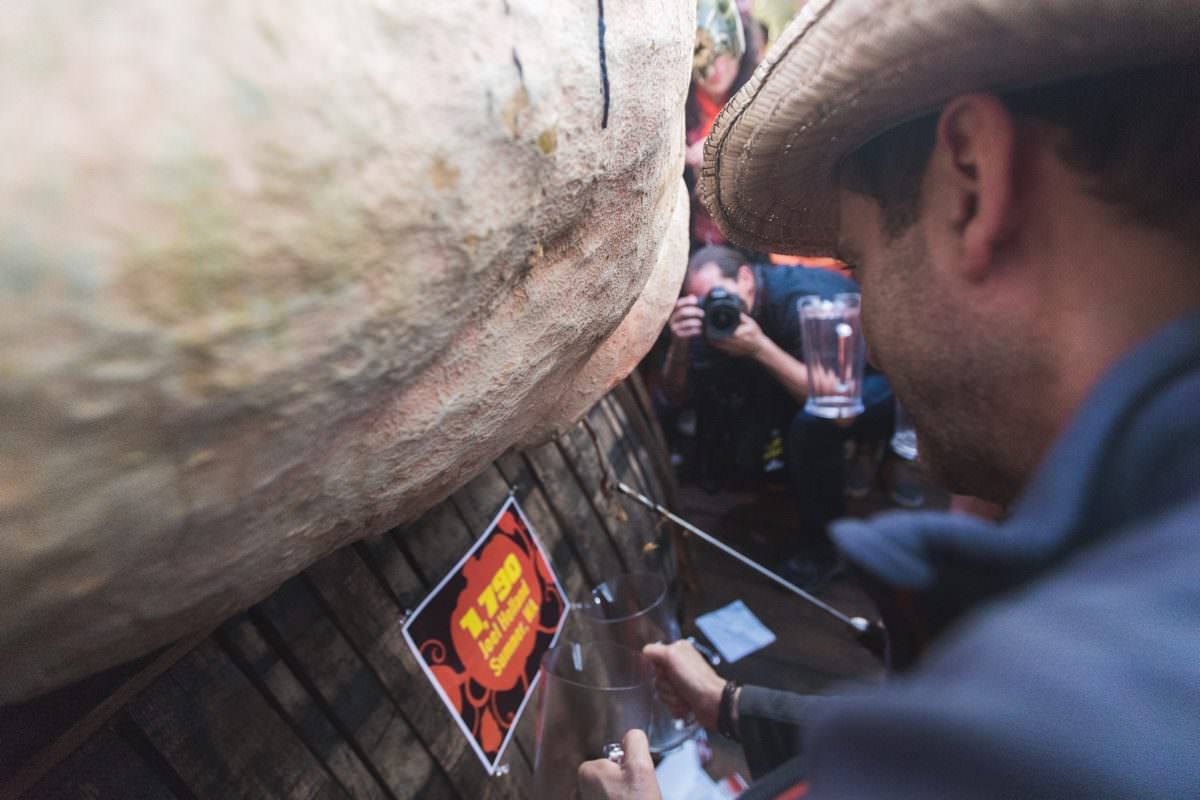How Elysian Brewing Company Turns a 1,790-Pound Pumpkin Into a Keg
And is this insane thing really a pumpkin?
How Elysian Brewing Company Turns a 1,790-Pound Pumpkin Into a Keg
And is this insane thing really a pumpkin?

A whopping 50 breweries, mostly from the western United States, treked to the Seattle Center, just north of Pike Place Market, to participate in the festival, which spanned the last two weekends of September. The festival has all your normal fall activities – carving stations, food trucks, costume competitions, and such. But the highlight? A giant pumpin keg. Each year, Seattle-based Elysian Brewing Company takes an insanely huge pumpkin and turns it into a keg for one of their dozen-plus pumpkin beers. (This year, their selection included Hi-P, a hibiscus-pumpkin blend; Night Owl ale; One-Eye Jackie pumpkin wheatwine; and Crust Punk pumpkin kvass.)
The chosen pumpkin was a 1,790-pound monster provided by Joel Holland, a local farmer who grew it specifically for the festival. We got the chance to talk with Holland, and the first question was obvious: what exactly are these insane, jumbo-sized things?
Pumpkin or Squash?
It turns out that “pumpkin” is not a strict categorization – it’s more like a loose description of a squash, and most squash are just variants of one species, Cucurbita pepo, that’s been selectively bred to have thousands of different shapes and colors. That one species includes such seemingly unrelated varieties as zucchini, sugar baby pumpkins, and pattypan squash. All the same species! The Atlantic Giant pumpkin, which is what the keg was made from, Holland told me, is also a member of this tribe.
To call a squash a pumpkin, it has to be a hard fall or winter squash with a generally round shape and an orange, cream, or white color. But there’s also the stem to examine. “Squash are said to have a softer, round stem. Under this definition, the Atlantic giant would be a squash. One obvious problem with this logic is to examine a zucchini, which has a hard 5 sided stem, but is universally called a squash,” wrote Holland in an email.

The Atlantic Giant dates back to one prize-winning squash in the early 1980s, but growers have figured out all kinds of ways to encourage this crazy squash to grow ever faster, bigger, and heavier. Fungal treatments to encourage more nutrient intake, covering them with a protective blanket at night – giant pumpkin farmers will try anything.
The other thing about this particular crop is that it’s not good for eating. At all. Holland describes the flavor as “insipid,” noting that the Atlantic Giant is an especially bland variety. It is grown almost exclusively for competitions, and it’s not cheap to do that. “The Atlantic Giant is a large plant. Most growers allow 600 to 1,000 sq. ft. per plant,” says Holland.”The time, effort, and expense lavished on these giants would not be cost effective for most other crops.”
Making an Atlantic Giant Keg
Making your own pumpkin keg out of a typical pumpkin is not particularly hard; you simply cut off the top, scrape out the guts and seeds, cut a small hole a few inches from the base to insert a tap, then fill with beer. But that same process with a pumpkin that weighs nearly a ton is a bit harder. For one thing, a forklift is needed just to move the beast. After that, the Elysian team uses a Sawzall, a drill, and a cutting torch to blast through the wall of the pumpkin, which can be up to 16 inches thick. The lid alone, says Dan-o Beyer, the cellarmaster at Elysian, can be 80 pounds in weight. Scraping the inside is also difficult; the person doing the work has to go head-first into the pumpkin from the top to get the job done. Beyer says they usually pull about 15 to 20 gallons of guts out of one of these pumpkins.
“The very first time we created a pumpkin keg, we noticed an unmistakable, raw pumpkin taste that distracted from the flavor of the beer,” says Beyer. After that, they started blowtorching the inside of the pumpkin to remove some of that raw squash taste. There’s also a danger of cracking or splitting; as these pumpkins get bigger, they can hold more beer, but the greater weight of beer can also make them vulnerable to splitting. This year, Beyer says they used four kegs worth of beer – almost 250 gallons.

But after all that, the end product is worth it, both for fun and flavor. Pumpkin, says Joe Bisacca, the co-founder and CEO of Elysian Brewing, is a natural flavor match with beer. “Produce for me has always been part of the brewing process. Hops themselves are vegetal. Think of the base flavors – hops add spiciness, pine, floral, and citrus flavors and smells. So does produce. Pumpkin fills a malt flavor characteristic,” he says. Oh, and if you’re wondering: his pumpkin beer is brewed with actual pumpkin, unlike “pumpkin spice” products which are merely prepared with the spices used in a pumpkin pie.
Follow us
This work is licensed under a Creative Commons Attribution-NoDerivatives 4.0 International License.
Want to republish a Modern Farmer story?
We are happy for Modern Farmer stories to be shared, and encourage you to republish our articles for your audience. When doing so, we ask that you follow these guidelines:
Please credit us and our writers
For the author byline, please use “Author Name, Modern Farmer.” At the top of our stories, if on the web, please include this text and link: “This story was originally published by Modern Farmer.”
Please make sure to include a link back to either our home page or the article URL.
At the bottom of the story, please include the following text:
“Modern Farmer is a nonprofit initiative dedicated to raising awareness and catalyzing action at the intersection of food, agriculture, and society. Read more at <link>Modern Farmer</link>.”
Use our widget
We’d like to be able to track our stories, so we ask that if you republish our content, you do so using our widget (located on the left hand side of the article). The HTML code has a built-in tracker that tells us the data and domain where the story was published, as well as view counts.
Check the image requirements
It’s your responsibility to confirm you're licensed to republish images in our articles. Some images, such as those from commercial providers, don't allow their images to be republished without permission or payment. Copyright terms are generally listed in the image caption and attribution. You are welcome to omit our images or substitute with your own. Charts and interactive graphics follow the same rules.
Don’t change too much. Or, ask us first.
Articles must be republished in their entirety. It’s okay to change references to time (“today” to “yesterday”) or location (“Iowa City, IA” to “here”). But please keep everything else the same.
If you feel strongly that a more material edit needs to be made, get in touch with us at [email protected]. We’re happy to discuss it with the original author, but we must have prior approval for changes before publication.
Special cases
Extracts. You may run the first few lines or paragraphs of the article and then say: “Read the full article at Modern Farmer” with a link back to the original article.
Quotes. You may quote authors provided you include a link back to the article URL.
Translations. These require writer approval. To inquire about translation of a Modern Farmer article, contact us at [email protected]
Signed consent / copyright release forms. These are not required, provided you are following these guidelines.
Print. Articles can be republished in print under these same rules, with the exception that you do not need to include the links.
Tag us
When sharing the story on social media, please tag us using the following: - Twitter (@ModFarm) - Facebook (@ModernFarmerMedia) - Instagram (@modfarm)
Use our content respectfully
Modern Farmer is a nonprofit and as such we share our content for free and in good faith in order to reach new audiences. Respectfully,
No selling ads against our stories. It’s okay to put our stories on pages with ads.
Don’t republish our material wholesale, or automatically; you need to select stories to be republished individually.
You have no rights to sell, license, syndicate, or otherwise represent yourself as the authorized owner of our material to any third parties. This means that you cannot actively publish or submit our work for syndication to third party platforms or apps like Apple News or Google News. We understand that publishers cannot fully control when certain third parties automatically summarize or crawl content from publishers’ own sites.
Keep in touch
We want to hear from you if you love Modern Farmer content, have a collaboration idea, or anything else to share. As a nonprofit outlet, we work in service of our community and are always open to comments, feedback, and ideas. Contact us at [email protected].by Dan Nosowitz, Modern Farmer
October 24, 2017
Modern Farmer Weekly
Solutions Hub
Innovations, ideas and inspiration. Actionable solutions for a resilient food system.
ExploreExplore other topics
Share With Us
We want to hear from Modern Farmer readers who have thoughtful commentary, actionable solutions, or helpful ideas to share.
SubmitNecessary cookies are absolutely essential for the website to function properly. This category only includes cookies that ensures basic functionalities and security features of the website. These cookies do not store any personal information.
Any cookies that may not be particularly necessary for the website to function and are used specifically to collect user personal data via analytics, ads, other embedded contents are termed as non-necessary cookies.